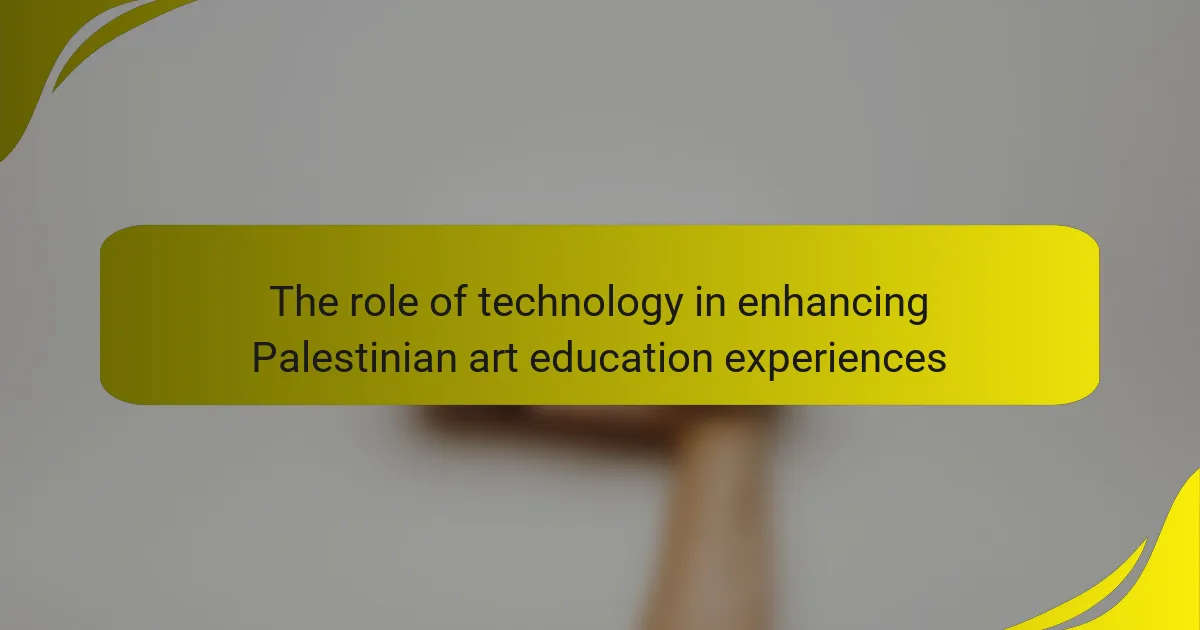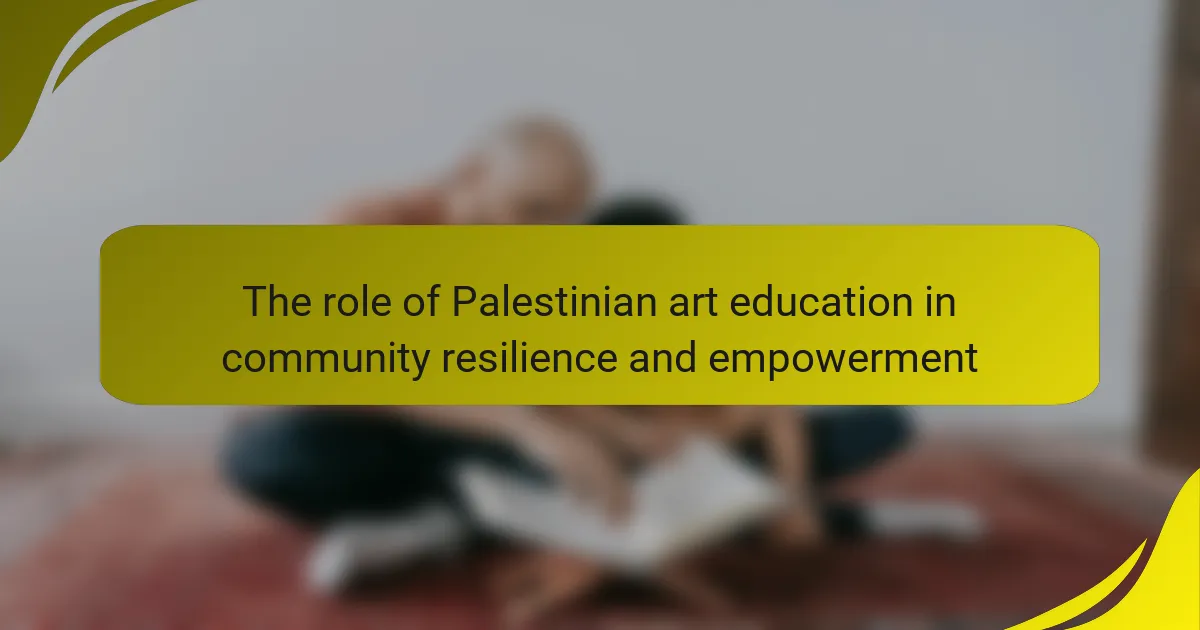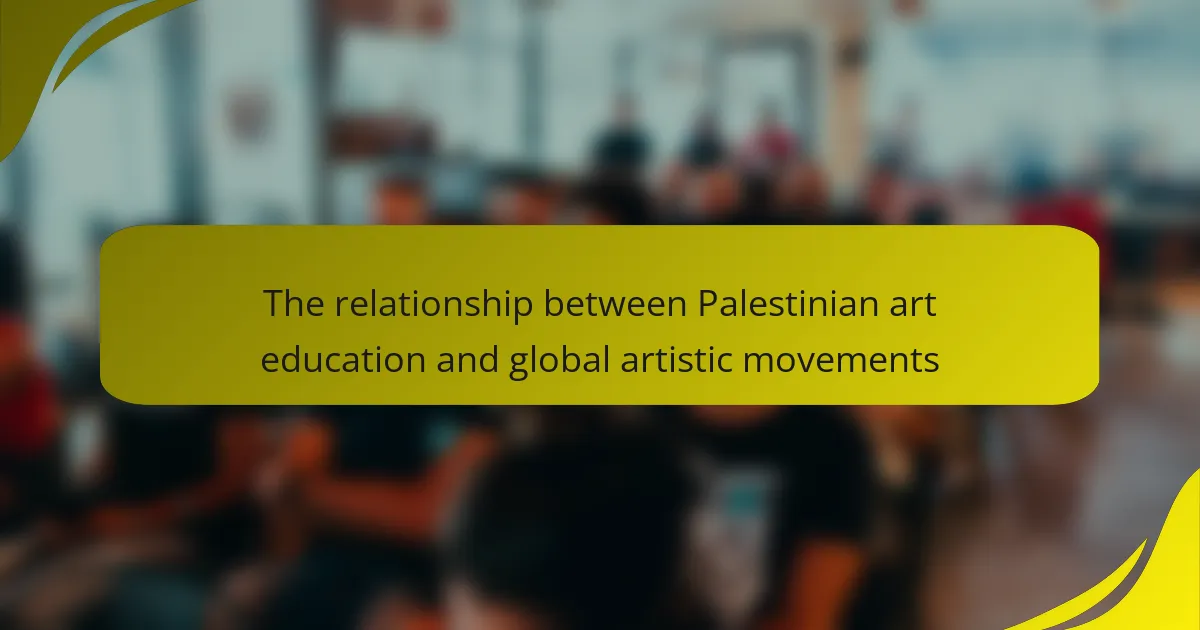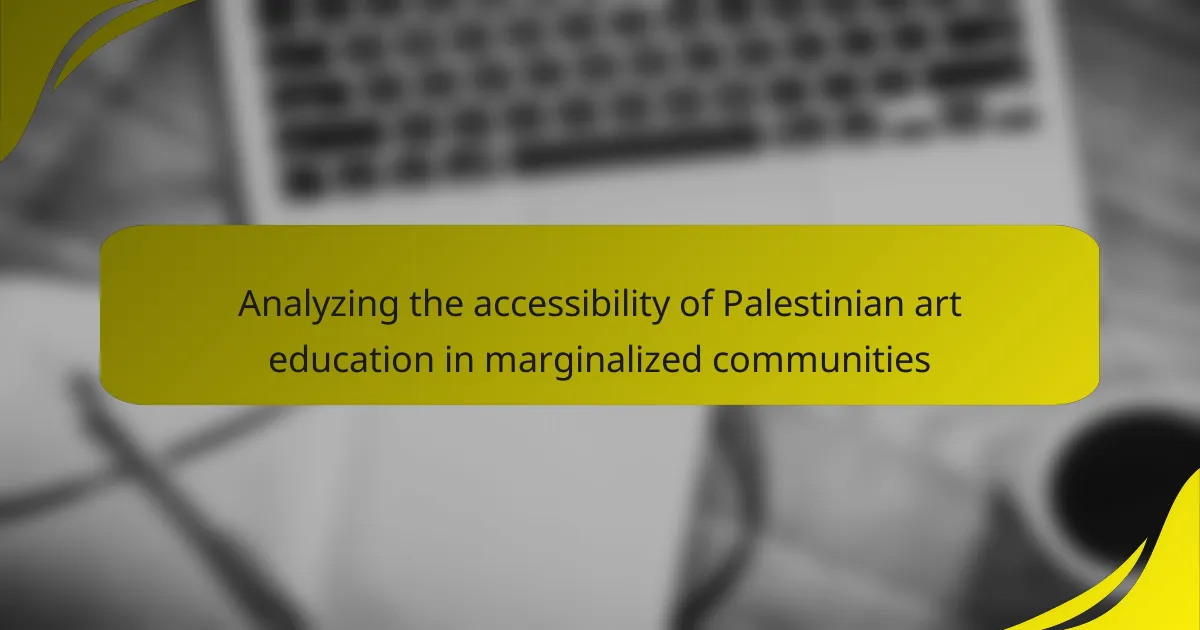Palestinian art education is a teaching system that focuses on the artistic practices and cultural heritage of Palestine, encompassing various forms of visual arts such as painting, sculpture, and traditional crafts. This educational framework aims to foster creativity, critical thinking, and a strong connection to Palestinian identity and culture among students. Key techniques taught include drawing, painting, and calligraphy, which are essential for expressing cultural narratives. Additionally, the curriculum integrates local history and social issues, promoting community engagement and collaboration among artists and educators. Through workshops and exhibitions, Palestinian art education facilitates cultural preservation and reinforces community ties, contributing to resilience and cultural continuity among youth.
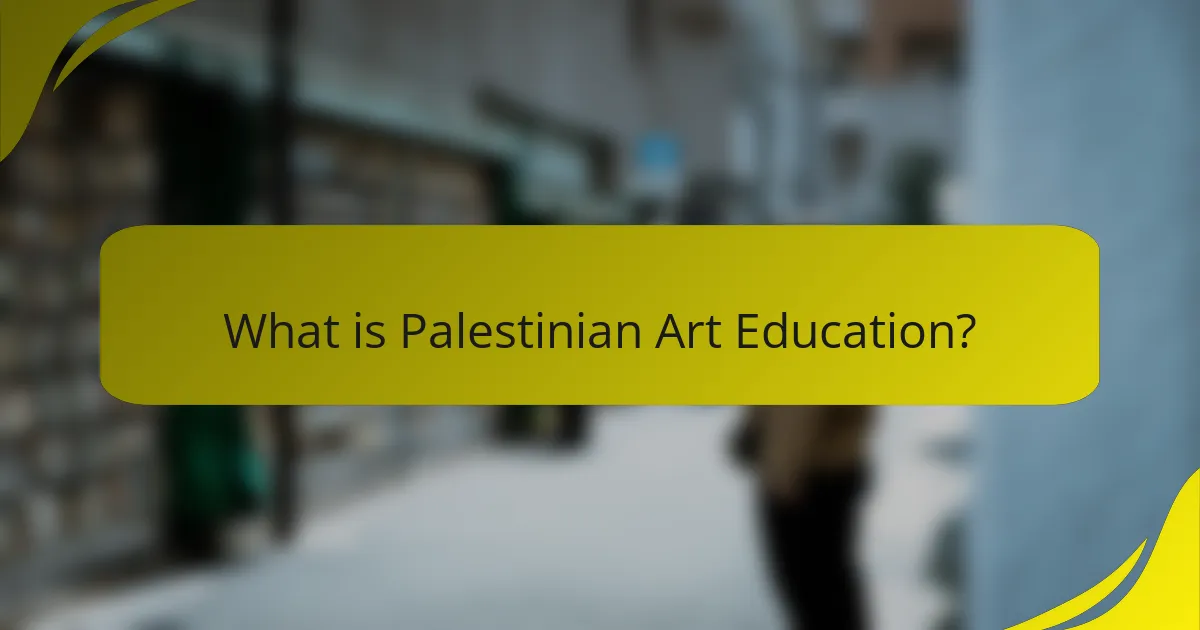
What is Palestinian art education?
Palestinian art education is a system of teaching that focuses on the artistic practices and cultural heritage of Palestine. It encompasses various forms of visual arts, including painting, sculpture, and traditional crafts. The education aims to foster creativity and critical thinking among students. It also emphasizes the importance of preserving Palestinian identity and culture through art. Institutions and programs often incorporate local history and social issues into their curricula. This approach helps students connect with their cultural roots. Additionally, Palestinian art education promotes community engagement and collaboration among artists and educators.
How has Palestinian art education evolved over time?
Palestinian art education has evolved significantly over time. Initially, art education in Palestine was informal and community-based. Traditional crafts and skills were passed down through generations. In the mid-20th century, formal art institutions began to emerge. The establishment of the Palestine Art Academy in 1994 marked a significant milestone. This institution aimed to provide structured education in various art forms. Over the years, art education has increasingly incorporated contemporary practices. Today, it emphasizes both cultural heritage and modern artistic expressions. The impact of political and social changes has also influenced art curricula. Art educators now focus on fostering critical thinking and creativity among students.
What historical influences shaped Palestinian art education?
Palestinian art education has been shaped by various historical influences, including cultural heritage, political conflict, and educational reforms. The rich cultural heritage of Palestine has fostered a deep appreciation for traditional arts, such as embroidery and pottery. Political conflicts, particularly the Israeli-Palestinian conflict, have influenced artistic expression and educational focus. The establishment of art institutions, like the International Academy of Art Palestine, has aimed to preserve and promote Palestinian cultural identity. Additionally, educational reforms throughout the 20th century sought to integrate contemporary art practices into the curriculum. The influence of global art movements has also impacted Palestinian art education, leading to a blending of traditional and modern techniques. These historical influences collectively shape the current landscape of art education in Palestine.
How do cultural and political contexts impact art education in Palestine?
Cultural and political contexts significantly impact art education in Palestine. The ongoing conflict and occupation influence curriculum content and accessibility. Art education often reflects themes of resistance and identity. Cultural heritage is emphasized to preserve Palestinian history. Restrictions on movement hinder access to resources and professional training. Political narratives shape the subjects taught in art classes. Local and international collaborations can enhance educational opportunities. However, funding limitations affect program sustainability and development. These factors collectively shape the landscape of art education in Palestine.
What are the primary methods used in Palestinian art education?
The primary methods used in Palestinian art education include studio-based learning, community engagement, and cultural heritage integration. Studio-based learning emphasizes hands-on practice in various artistic techniques. This method allows students to explore their creativity and develop technical skills. Community engagement involves collaboration with local artists and cultural organizations. It fosters a connection between students and their cultural identity. Cultural heritage integration teaches students about Palestinian history and traditions through art. This method helps preserve cultural narratives and promotes awareness. These methods collectively aim to empower students and enrich their artistic expression.
How do traditional techniques play a role in art education?
Traditional techniques are essential in art education as they preserve cultural heritage and foster skill development. They provide students with foundational skills in drawing, painting, and sculpting. These techniques often reflect the historical and cultural contexts of the region. For instance, traditional Palestinian embroidery teaches students about identity and storytelling. Mastery of these techniques enhances creativity and critical thinking. Furthermore, they connect learners to their cultural roots, promoting a sense of belonging. Studies show that incorporating traditional methods in curricula leads to improved artistic expression. Thus, traditional techniques significantly enrich art education by blending skill acquisition with cultural preservation.
What contemporary methods are being adopted in Palestinian art education?
Contemporary methods in Palestinian art education include community-based art initiatives and interdisciplinary approaches. These methods emphasize collaboration between artists and educators. They focus on integrating traditional Palestinian art forms with modern techniques. Workshops and exhibitions are key components of this educational approach. Digital media is increasingly utilized to expand artistic expression. Art education also incorporates social and political themes relevant to Palestinian identity. This approach aims to foster critical thinking among students. Evidence shows that these methods enhance engagement and cultural awareness in art education.
Why is cultural preservation important in Palestinian art education?
Cultural preservation is vital in Palestinian art education because it safeguards the unique heritage of the Palestinian people. This education fosters identity and continuity through artistic expression. It enables students to connect with their history, traditions, and cultural narratives. Furthermore, preserving culture through art helps counteract external influences and narratives. Studies show that cultural education enhances community resilience and cohesion. It empowers individuals to articulate their experiences and perspectives. Ultimately, cultural preservation in art education plays a crucial role in maintaining the Palestinian identity amidst challenges.
How does art education contribute to cultural identity among Palestinians?
Art education contributes to cultural identity among Palestinians by fostering a sense of belonging and shared history. It enables individuals to express their unique experiences and narratives through various artistic mediums. This educational approach emphasizes traditional Palestinian themes, symbols, and techniques, reinforcing cultural heritage. Art education also encourages community engagement and collaboration, strengthening social ties. Furthermore, it serves as a platform for political expression and resistance, reflecting the struggles and aspirations of the Palestinian people. Studies show that participation in art programs enhances cultural awareness and pride among youth. For instance, the “Art and Identity in Palestine” research highlights how art education instills a deeper understanding of cultural roots and collective identity.
What challenges does Palestinian art education face in preserving culture?
Palestinian art education faces significant challenges in preserving culture. Limited resources hinder access to quality art materials and training. Political instability disrupts educational programs and creates an environment of uncertainty. The ongoing conflict affects the ability to express cultural identity through art. Censorship and restrictions on artistic expression further complicate the preservation of cultural narratives. Additionally, the lack of institutional support limits funding and opportunities for artists and educators. These factors collectively threaten the continuity of Palestinian cultural heritage in the realm of art education.
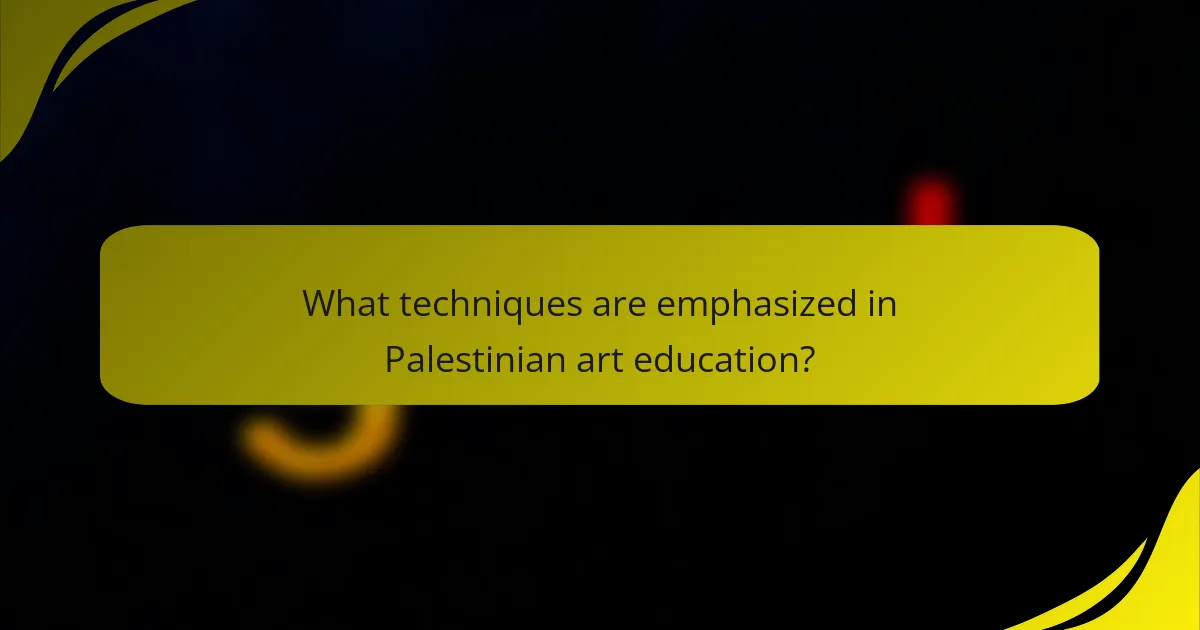
What techniques are emphasized in Palestinian art education?
Palestinian art education emphasizes techniques such as drawing, painting, and calligraphy. These techniques are integral to expressing cultural identity and heritage. Drawing is often used to develop observational skills and creativity. Painting techniques include watercolors and acrylics, which allow for vibrant expression. Calligraphy is a significant art form, reflecting historical and cultural narratives. Additionally, mixed media and digital art are increasingly incorporated to modernize practices. These techniques collectively foster a connection to Palestinian history and community.
How do various art forms contribute to education in Palestine?
Various art forms contribute to education in Palestine by fostering creativity and critical thinking. Art education enhances students’ engagement with cultural identity. It also promotes emotional expression and social cohesion. Visual arts, music, and theater serve as tools for storytelling and historical preservation. Programs often integrate traditional Palestinian themes, helping students connect with their heritage. Research indicates that art education improves academic performance and enhances problem-solving skills. For instance, a study by the Arab Educational Forum highlights the positive impact of art on student motivation. These contributions are vital in a context where educational resources may be limited.
What role do visual arts play in the Palestinian education system?
Visual arts play a significant role in the Palestinian education system. They serve as a medium for cultural expression and identity. Visual arts foster creativity and critical thinking among students. They also provide a platform for social commentary and political awareness. In Palestinian schools, art education is integrated into the curriculum. This integration helps students connect with their heritage and history. Research indicates that art education enhances students’ emotional well-being. Moreover, visual arts can promote community engagement and collaboration.
How are performing arts integrated into Palestinian art education?
Performing arts are integrated into Palestinian art education through various programs and initiatives. These initiatives include workshops, theater productions, and dance performances that emphasize cultural heritage. Educational institutions often collaborate with local artists to enhance curriculum offerings. Students engage in hands-on experiences that promote creativity and expression. The integration of performing arts helps preserve Palestinian cultural identity. It also fosters community engagement and social awareness among students. Research indicates that such integration enhances critical thinking and teamwork skills. Overall, performing arts play a vital role in enriching Palestinian art education.
What innovative techniques are emerging in Palestinian art education?
Innovative techniques in Palestinian art education include the integration of digital media and community-based projects. Digital media allows artists to explore new forms of expression and reach a broader audience. Community-based projects foster collaboration and cultural exchange among participants. These techniques promote social awareness and artistic dialogue. Recent workshops have focused on using technology to document and share local narratives. Additionally, interdisciplinary approaches combine art with history and social studies. This method enhances critical thinking and creativity among students. Evidence of these innovations can be seen in programs like the Palestinian Art Academy, which emphasizes contemporary practices.
How is technology influencing art education in Palestine?
Technology is significantly influencing art education in Palestine by enhancing accessibility and creativity. Digital tools enable students to explore various art forms and techniques. Online platforms facilitate collaboration among artists and educators. Virtual workshops and tutorials provide new learning opportunities. Access to global art movements and trends is improved through the internet. Additionally, technology aids in preserving Palestinian cultural heritage through digital archiving. For instance, initiatives like the Palestinian Museum’s digital projects showcase local artists and their works. This integration of technology fosters a more dynamic and inclusive art education environment in Palestine.
What collaborative projects enhance artistic techniques among students?
Collaborative projects that enhance artistic techniques among students include community mural projects and art exhibitions. These projects encourage teamwork and creativity. Students learn to communicate their ideas visually and conceptually. They also gain experience in planning and executing large-scale artworks. Research shows that participation in group art activities boosts artistic skills and confidence. For example, a study by the National Endowment for the Arts highlights the positive impact of collaborative art projects on student engagement and skill development. Additionally, cross-cultural art exchanges foster diversity and broaden artistic perspectives. These collaborative efforts ultimately enrich the educational experience in Palestinian art education.
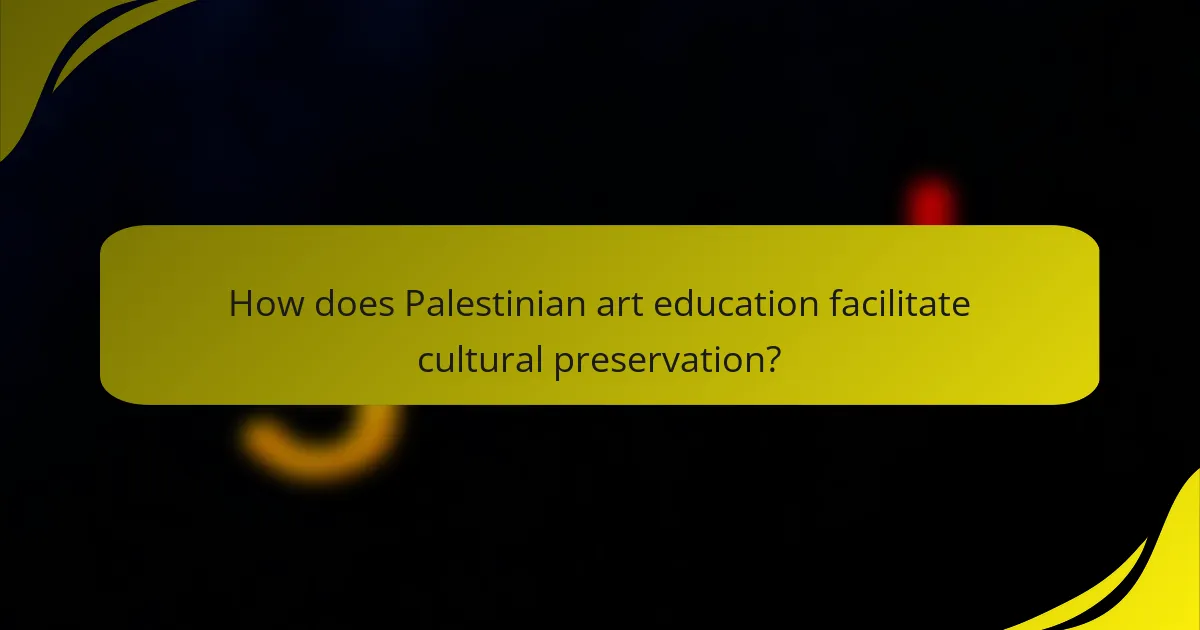
How does Palestinian art education facilitate cultural preservation?
Palestinian art education facilitates cultural preservation by teaching traditional artistic techniques and cultural narratives. Students learn to create art that reflects their heritage. This education reinforces identity and community ties. Art programs often incorporate local history and folklore. By engaging with these elements, students develop a deeper connection to their culture. Workshops and exhibitions showcase traditional crafts and contemporary interpretations. This visibility helps sustain cultural practices. Research indicates that art education fosters resilience and cultural continuity among Palestinian youth.
What initiatives are in place to support cultural preservation through art?
Initiatives to support cultural preservation through art include various educational programs and community projects. These initiatives aim to promote traditional Palestinian art forms. They involve workshops, exhibitions, and collaborations with local artists. Organizations like Al-Quds University offer courses in traditional art techniques. Additionally, non-profits host events to showcase Palestinian heritage. Grants and funding are provided to support artists and cultural projects. These efforts help maintain cultural identity despite external pressures. They also encourage younger generations to engage with their cultural history.
How do local communities engage with art education for cultural preservation?
Local communities engage with art education for cultural preservation by implementing programs that teach traditional art forms. These programs often include workshops, classes, and community events focused on local artistic practices. For instance, Palestinian communities may host sessions on embroidery, pottery, and calligraphy, which are vital to their cultural identity. Schools and local organizations collaborate to integrate these art forms into curricula. This engagement fosters intergenerational knowledge transfer, ensuring that younger generations learn these skills. Research shows that such initiatives enhance community cohesion and cultural pride. According to a study by the Palestinian Art Academy, participation in art education significantly boosts awareness of cultural heritage among youth.
What role do educational institutions play in preserving Palestinian heritage?
Educational institutions play a crucial role in preserving Palestinian heritage. They serve as centers for cultural education and transmission. Schools and universities incorporate local history and traditions into their curricula. This approach fosters a sense of identity and belonging among students. Additionally, institutions often organize workshops and events focused on traditional arts and crafts. Such activities help to engage the community and promote cultural practices. Research indicates that educational programs enhance awareness of Palestinian heritage. For example, the Palestinian Ministry of Education emphasizes cultural education in its guidelines. This commitment ensures that heritage is valued and passed down to future generations.
What best practices can enhance Palestinian art education?
Integrating community engagement in Palestinian art education enhances its effectiveness. Community involvement fosters a sense of belonging and cultural identity. Collaborations with local artists can provide mentorship opportunities. These partnerships can also lead to the sharing of traditional techniques. Incorporating diverse art forms can enrich the curriculum. This approach encourages creativity and innovation among students. Providing access to resources like art supplies and workshops is essential. Research shows that resource availability significantly impacts educational outcomes. Programs that promote cultural heritage through art can strengthen community ties.
How can educators effectively incorporate cultural elements into their teaching?
Educators can effectively incorporate cultural elements into their teaching by integrating local art forms and historical contexts into the curriculum. This approach promotes cultural relevance and engages students in meaningful ways. For instance, using Palestinian art as a case study can enhance students’ understanding of national identity and heritage. Additionally, educators can invite local artists to conduct workshops, providing firsthand experience and fostering community connections. Incorporating traditional stories and folklore into lessons can also enrich students’ cultural awareness. Research shows that culturally responsive teaching improves student engagement and academic performance. A study by [censured] (2010) highlights that students perform better when their cultural backgrounds are reflected in the learning environment.
What resources are available for promoting art education in Palestine?
Art education in Palestine is supported by various resources. Non-governmental organizations (NGOs) provide funding and training programs. Institutions like the International Academy of Art Palestine offer structured art courses. Local community centers host workshops and exhibitions to engage youth. Online platforms facilitate access to art education materials. Collaborations with international art organizations enhance exposure and opportunities. Grants from cultural foundations assist in project development. Educational partnerships with universities promote research and curriculum development. These resources collectively aim to foster artistic skills and cultural expression among Palestinians.
Palestinian art education is a structured system focused on the artistic practices and cultural heritage of Palestine, encompassing various visual arts and traditional crafts. The article explores its evolution, historical influences, and the impact of cultural and political contexts on the curriculum. It highlights primary methods such as studio-based learning and community engagement, while also discussing the importance of traditional techniques and contemporary practices in preserving Palestinian identity. Additionally, it examines challenges faced in cultural preservation and the role of educational institutions and community initiatives in enhancing art education.
